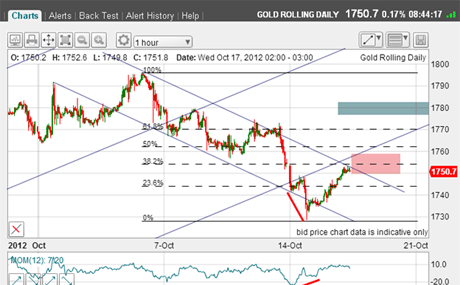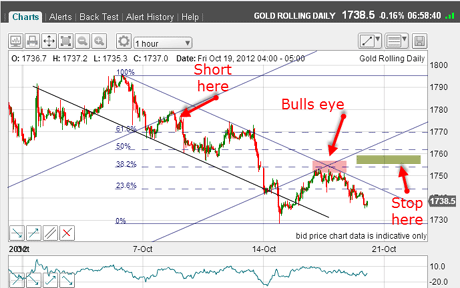The anatomy of a gold trade
John C Burford looks at a recent trade in gold which illustrates beautifully how to manage a swing trade.
Before I start on today's topic, I want to comment on yesterday's sudden plunge in Google shares, which wiped out a greater dollar wealth ($14bn) in just a few moments than has ever occurred in stock market history.
Talk about today's traders having a hair trigger! But this vividly illustrates how jumpy the markets are today. Markets are highly fractured and polarised and getting more so. At some point, the Google experience will surely be repeated in many other markets. That is when I want to be short everything on the board!
But back to today's coverage, and I want to follow up on the gold story, as it illustrates how a swing trade can be managed professionally. I hope you can use this example as a blueprint in managing your own swing trades.
MoneyWeek
Subscribe to MoneyWeek today and get your first six magazine issues absolutely FREE

Sign up to Money Morning
Don't miss the latest investment and personal finances news, market analysis, plus money-saving tips with our free twice-daily newsletter
Don't miss the latest investment and personal finances news, market analysis, plus money-saving tips with our free twice-daily newsletter
I have made it plain that I take a negative attitude to the long side of gold, and have spelled out my reasoning in previous articles. Of course, this is dead set against most opinions - but if conditions change, then I'll change my opinions.
I have largely stayed out of the market during the huge bull run since the summer. But it has become a classic crowded trade with bullish consensus up near record highs. This is always a warning sign to me.
Many have viewed the $1,800 level as a target and resistance, and I have showen that since the market failed by a mere $4 to hit the target, the bulls, who were waiting for the $1,800 print, would be seeing their profits shrink before their eyes. As each day has passed since the 5 October high, many would be kicking themselves for being greedy and not taking the massive profits on offer!
Don't worry, this is a common experience. And this is where the necessity of having a timeframe in mind comes into play. If you are a long-term investor, then this dip would not overly worry you. But if you are more short-term oriented, this decline will be of immediate concern.
A classic error in trading is to move away from an original shorter-term view to a market-imposed long-term view: "It will come right, don't worry". These are some of the most dangerous words in finance, because if it doesn't, you will be wiped out.
Remember - the cynic's definition of a long-term investment is a short-term speculation that went wrong.
Don't be a cynic!
And that is why I advocate using protective stops on all positions and here is a great example of how to manage your stops.
On Wednesday, the market had fallen to the $1,730 area and was staging a rally to correct the oversold condition. I had a solid resistance zone mapped out from the meeting of two tramlines and a Fibonacci level:

(Click on the chart for a larger version)
I was holding a short trade taken at the $1,775 area on a break and kiss of the centre tramline. The pink zone was my target top for the rally, and the blue zone was my line in the sand for my bearish position.
And this morning, this is the situation:

(Click on the chart for a larger version)
The market eventually bounced off my target zone and is currently headed lower off the tramline (yet another example of tramline-as-resistance!).
As for my stop placements, my original place was around $1,790, but as the market declined, I moved it to break-even.
And this morning, with the new leg down, I am moving it to just above this week's high in the $1,755 area. I could place it closer, say just above the upper tramline in the $1,745 area. But I know that gold is notorious for spiking out of a tramline and then sneaking back inside. I will give it a little more room.
So now, no matter what occurs, I am guaranteed a profit. If the market suddenly rallies to my stop, I will take a $20 profit from this trade. Nice.
But if the market moves below the $1,730 low, much larger gains are on the cards, and I will of course observe what kind of action ensues as this will guide me in further managing my trade.
So you see, this style of conservative trade management is low stress. I am not constantly wondering what to do whether to take profits or get out after reading some article or other. I will let the market decide whether to take me out or not, or whether to bestow great riches on a truly deserving trader.
Next week, I will cover the Dow and the euro as they have rallied into crucial levels.
If you're a new reader, or need a reminder about some of the methods I refer to in my trades, then do have a look at my introductory videos:
The essentials of tramline trading
An introduction to Elliott wave theory
Advanced trading with Elliott waves
Don't miss my next trading insight. To receive all my spread betting blog posts by email, as soon as I've written them, just sign up here . If you have any queries regarding MoneyWeek Trader, please contact us here.
Get the latest financial news, insights and expert analysis from our award-winning MoneyWeek team, to help you understand what really matters when it comes to your finances.
John is is a British-born lapsed PhD physicist, who previously worked for Nasa on the Mars exploration team. He is a former commodity trading advisor with the US Commodities Futures Trading Commission, and worked in a boutique futures house in California in the 1980s.
He was a partner in one of the first futures newsletter advisory services, based in Washington DC, specialising in pork bellies and currencies. John is primarily a chart-reading trader, having cut his trading teeth in the days before PCs.
As well as his work in the financial world, he has launched, run and sold several 'real' businesses producing 'real' products.
-
 Revealed: The 10 UK locations which could see the biggest house price growth in 2026
Revealed: The 10 UK locations which could see the biggest house price growth in 2026Scotland leads the way for house price growth in 2026 according to Zoopla, but what regions will do the best in 2026?
-
 Could pensions inheritance tax rule change create liquidity crisis for Sippholders?
Could pensions inheritance tax rule change create liquidity crisis for Sippholders?Pension inheritance tax rule changes from April 2027 could create a liquidity crisis for some self-invested personal pensions (Sipps) holding commercial property. We reveal what you can do to mitigate the impact.